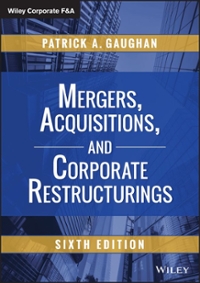Question
(Case and requirements c, d, and e are reprinted from Journal of Accounting Education , Vol. 15, Charles E. Davis, Accounting Is Like a Box
(Case and requirements c, d, and e are reprinted fromJournal of Accounting Education, Vol. 15, Charles E. Davis, "Accounting Is Like a Box of Chocolates: A Lesson in Cost Behavior," 307-308, Copyright (1997), with permission from Elsevier.)
Forrest Gumpwas one of the biggest movie hits of 1994. The movie's fortunes continued to climb in 1995, as it took home Oscars in six of 13 categories in which it was nominated, including best picture, best director, and best actor. One analyst has estimated that the film could generate cash flow as much as $350 million for Viacom, Inc., Paramount Pictures' parent company. Such success has insured the film a place among the top grossing films of all time. This is quite an accomplishment for a movie that took nine years to make it to the big screen and whose script was not considered material likely to generate a runaway movie hit.
But wasForrest Gumpa money maker for Paramount in 1994? Films are typically distributed to theaters under an agreement that splits the gross box office receipts approximately 50/50 between the theater and the movie studio. Under such an agreement, Paramount had received $191 million in gross box office receipts from theaters as of December 31, 1994. Paramount reports that the fi lm cost $112 million to produce, including approximately $15.3 million each paid to star Tom Hanks and director Robert Zemeckis, and "production overhead" of $14.6 million. This production overhead is charged to the movie at a rate equal to 15% of other production costs.
Not included in the $112 million production costs were the following other expenses associated with the film. Promotion expenses incurred to advertise, premiere, screen, transport, and store the film totaled $67 million at the end of 1994. An additional $6.7 million "advertising overhead charge" (equal to 10% of the $67 million promotion expenses) was charged to the film by Paramount. These charges represent the film's allocation of the studio's cost of maintaining an in-house advertising department. Paramount also charged the fi lm a "distribution fee" of 32% of its share of gross box office receipts. This fee is the film's allocation of the costs incurred by Paramount to maintain its studio-wide distribution services. Finally, $6 million in interest on the $112 million in production costs were charged to the film by Paramount.
a. Identify each of the costs mentioned above as a product or period cost.
b. What application bases did Paramount use to apply overhead to this "job"?
c. WasForrest Gumpan "accounting" hit in terms of net income, as computed by Paramount?
Step by Step Solution
There are 3 Steps involved in it
Step: 1

Get Instant Access to Expert-Tailored Solutions
See step-by-step solutions with expert insights and AI powered tools for academic success
Step: 2

Step: 3

Ace Your Homework with AI
Get the answers you need in no time with our AI-driven, step-by-step assistance
Get Started


